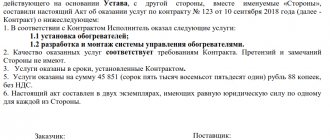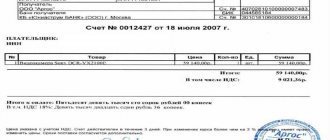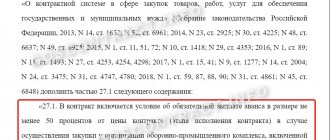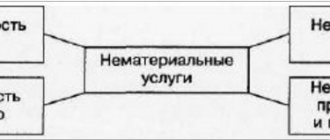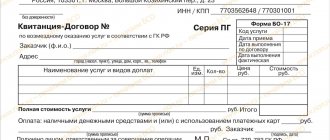Why is this necessary?
This document is primary; it provides confirmation of the fact that the obligations provided for under the terms of the agreement are 100% fulfilled. The act is a bilateral document; it is signed by both parties, called the contractor and the customer, respectively. The document will have a certain legal force even in the situation where the signing was carried out by one party. However, in this case, it is necessary to confirm the fact of refusal of the other participant, including using the signatures of witnesses.
With the help of a certificate of completed work, it will not be difficult to protect yourself from the formation of disagreements that may arise between contractors. If a conflict situation does arise, the document will constitute the main evidence in the judicial body. If the customer is not satisfied with the result obtained, all his claims will be reflected in this paper.
Act and accounting of the organization
The certificate of completion of work refers to the primary accounting documents on the basis of which payment is made. In addition, this document, together with the contract, can be used during legal proceedings or to calculate the statute of limitations. This is clearly stated by Federal Law-129 “On Accounting”, which states that all business transactions carried out by an organization of any form of ownership must be reflected in accounting.
Not everyone knows that for incorrect execution of the act, fines (or additional taxes) may be imposed on the organization, and the tax authorities may exclude the costs indicated in such acts from the costs when calculating income tax, and this is already quite serious.
The dates indicated in such documents are of great importance for attributing them to a specific reporting period, and untimely submission of acts may lead to a violation in the attribution of costs. Consequently, the income tax for a specific period will be underestimated or overestimated. In addition, expenses to reduce tax must be related to the activities of the organization. Article 9 of the Accounting Law lists all the details that are of decisive importance during registration. Therefore, before drawing up an act, you should carefully study this law.
Legal regulation
The basic documents on this issue include the following provisions of the Civil Code of the Russian Federation:
- Art. 753 - it states that it is necessary to draw up an act used as evidence of the fact of the activities carried out;
- Art. 752 – disclosure of the main nuances, provision of information to prevent misunderstandings with the tax authorities.
Along with this, it is worth taking into account the norms of Federal Law No. 402 of December 6, 2011. This provision states that the act in question is a primary document.
What does the paper look like?
The legislation of the Russian Federation does not contain a unified form of the document. Key criteria are regulated within the framework of Federal Law No. 402. It is also worth considering that in the process of forming this form, you can take into account the KS-2 or KS-3 form. Along with this, it is permissible to replace the deed and use a transfer document instead.
Regardless of which sample is selected and used, in a generalized form the paper includes a certain set of information:
- Name;
- personal number for identification;
- the period of time during which formation occurs;
- details of participants;
- list of events held;
- the time frame within which they were completed and submitted;
- information about the persons signing the document.
Only those representatives who have official authority to perform these actions have the right to endorse the paper in question. If counterparties use seals, although this item has not been mandatory since 2015, they must be affixed to the form. If we take into account the provisions of the contract, with their help the form of the act can be approved within the framework of preliminary agreements, at least this practice works when concluding contracts for large amounts. Sometimes this happens immediately before the document is issued.
Regardless of the circumstances, the work completion certificate, which is drawn up with high quality, simply must meet two requirements:
- the importance of displaying the name of the document on the basis of which the formation took place;
- the importance of indicating a clear range of activities performed.
It is important that the list of works in the application and the act is the same. The document requires displaying how the customer verifies the number of actions performed, as well as their quality. This can also easily include a visual inspection, testing activities in terms of functionality, etc. An important role is also played by indicating the place of acceptance of the work that was performed, as well as the date. If any party has any comments regarding the other party, they must be indicated in the act.
Based on the rental agreement
In accordance with the norms of current legislation, persons who have leased commercial premises assume financial responsibility for the property that is used. After completing this document, the landlord automatically issues a waiver of all possible claims against the tenant.
There are several principles that should be adhered to in the process of forming an act without fail:
- the document is drawn up strictly in writing;
- it must certainly have a serial number;
- information is provided that identifies the property leased;
- details of the rental agreement are indicated;
- the size (amount) of payment is fixed, taking into account value added tax;
- both parties affix their signatures;
- an indication of the full scope of obligations and that they have been fulfilled 100%;
- confirmation of the fact of full payment of the due amounts, which will help prove the absence of any claims.
It is important to sign each page of the document; only with this approach can you reduce the risk that individual sheets will be replaced.
It is important! The act in question is needed in order to submit it to various authorities, for example, to the tax service.
The procedure for issuing a certificate of completion of work
For individual entrepreneurs, there are no special rules and regulations regarding the procedure for drawing up acts of work performed, including their content; they draw it up in a general manner.
The current legislation does not establish a unified form for the act of completion of work. The exception is certain business sectors. For example, taxpayers engaged in construction can use the form of the act of acceptance of completed work No. KS-2, approved by Resolution of the State Statistics Committee of Russia dated November 11, 1999 No. 100.
It should be taken into account that the taxpayer can, in addition to the forms of primary accounting documents approved by authorized bodies, use independently developed forms of primary accounting documents, the form and content of which must comply with the requirements for primary accounting documents (Article 9 of Federal Law dated 06.12.2011 No. 402 -FZ “On Accounting”, Letter of the Ministry of Finance of Russia dated February 16, 2016 No. 03-03-06/1/8312).
Please note that when drawing up primary documents, not only organizations, but also individual entrepreneurs should be guided by the provisions of Law No. 402-FZ, despite the fact that individual entrepreneurs may not keep accounting records if, in accordance with tax legislation, they keep records of income or income and expenses and (or) other objects of taxation or physical indicators characterizing a certain type of business activity (clause 1, part 2, article 6 of Law No. 402-FZ).
Similar requirements are contained in clause 9 of the Procedure for accounting for income and expenses and business transactions for individual entrepreneurs (approved by Order of the Ministry of Finance of Russia No. 86n, Ministry of Taxes of Russia No. BG-3-04/430 dated 08/13/2002). This Procedure is used by individual entrepreneurs who apply the general taxation system.
A work completion certificate independently developed by an individual entrepreneur must contain the following details (Part 2, Article 9 of Law No. 402-FZ):
- Title of the document;
- details of the customer and contractor (if an individual entrepreneur, then his full name should be indicated);
- details of the agreement on the basis of which it was drawn up;
- list of work performed under the contract;
- an indication of the transfer of the work result to the customer;
- place and date of receipt of the result of the work performed;
- the customer’s comments on the quality of the work performed (if any) or an indication of their absence;
- the price of the work, including the amount of VAT if necessary;
- positions and personal signatures of the contractor and the customer or their authorized persons (if the act is signed by a person acting on the basis of a power of attorney, its details must be indicated in the act).
The seals of the parties, if available, are also affixed to the act.
Let us note that the provisions of Art. 9 of Law No. 402-FZ does not specify how detailed the work performed should be described. The Ministry of Finance of Russia in Letter No. 02-06-10/16186 dated 04/09/2014 also indicated that the act of completed work (services) is drawn up taking into account the requirements for the mandatory composition of details, the list of which does not contain requirements for the mandatory reflection of the details of the work (services) performed.
However, in practice, tax authorities require more detailed information in the work completion certificate, including the availability of information about the period of their completion. An analysis of arbitration practice indicates that the certificate of completion must contain information that allows one to identify a specific work (service), fully disclose the content of a business transaction, and detail its composition (volume, cost). Details of the work may be contained, for example, not in the act itself, but in the report attached to it. If neither the contract, nor the act, nor the report contain details of the work, then in such a situation the individual entrepreneur will most likely have to defend his right to account for expenses for tax purposes in court, and the prospect of litigation does not seem certain (Resolutions of the Federal Antimonopoly Service of the East Siberian district dated January 31, 2012 in case No. A19-6518/2011, FAS Moscow District dated January 11, 2010 No. KG-A40/14441-09).
Thus, to eliminate possible disagreements, it is recommended that the report describe the work performed in more detail.
The parties have the right to agree on the form of the act when concluding the contract. If the parties have agreed on the form of the act as an annex to the agreement, then it should be used. As a rule, the act is drawn up by the executor and offered to the customer for signing.
The acceptance certificate should be drawn up in two copies: one for the individual entrepreneur, the second for the counterparty. The act is a bilateral document and is signed by both parties to the previously executed contract - the contractor and the customer. The document will have legal force even if it is signed by only one party (the performer), but it must necessarily reflect the fact that the opposite party has refused to sign.
The parties have the right in the contract to establish a period for drawing up and signing the act, since it is not defined by law (Article 421 of the Civil Code of the Russian Federation). If the contract does not establish a specific deadline for signing the work completion certificate, the customer, in the absence of objections, is obliged to sign it within seven days and return it to the contractor (Clause 2 of Article 314 of the Civil Code of the Russian Federation).
Example. Certificate of completion
Nuances of signing a document
The customer is required to directly accept the work performed after he receives a corresponding message from the contractor. In Art. 720 and 753 of the Civil Code of the Russian Federation states that there are no exceptions for actions that are performed with poor quality. If the obligations involved any violations, it is possible to draw up a document:
- with comments;
- indicating the shortcomings;
- showing significant shortcomings.
After the problems have been resolved, the contractor is required to notify the customer of the relevant fact, as well as prepare a new acceptance certificate. Of course, the importance of notifying the customer is taken into account. If the latter somehow evades this procedure, a one-sided document is sent to him. If this does not work, the interested party has the right to file a claim with the fiscal authority.
In turn, the arbitration court in the process of considering a case may be guided by a unilateral act and assert that all actions were carried out with the highest possible quality and, most importantly, in full. As for legal force, it can be confirmed on the basis of Art. 753 of the Civil Code of the Russian Federation. If points regarding other contracts are taken into account, the practice of arbitration courts is taken into account.
Thus, the certificate of work performed is usually understood as a document of a bilateral nature, which indicates the absence of claims on the part of the customer against the contractor.
Antsupov Dmitry, Lawyer
Ask a lawyer a question:
What's app: +
Telegram: @dmi_try
Telegram channel: @lawyermoscow
Instagram: @jur_moscow
Cases of drawing up a certificate of completion of work
A certificate of completion of work must be drawn up, including by individual entrepreneurs, in the following cases:
- Acceptance of work under a contract (clause 2 of Article 720 of the Civil Code of the Russian Federation);
- Acceptance of work under a construction contract (clause 4 of Article 753 of the Civil Code of the Russian Federation).
In these cases, the process of accepting work under the contract and drawing up accompanying documents is clearly regulated; signing the act upon completion of the work is the responsibility of the parties, as well as sending a written notification if deficiencies in the work are detected. Otherwise, the work is considered uncompleted, therefore, there are no grounds for payment.
Also, the obligation for an individual entrepreneur to draw up a certificate of completion of work may follow from the contract if the parties included such an obligation in the contract (Article 421 of the Civil Code of the Russian Federation). The parties to the contract can draw up an act both upon completion of all work provided for in the contract, and at intermediate stages of the work. The regulatory authorities also note that drawing up a certificate of completion of work is necessary even when it is directly provided for by the contract itself (Letter of the Ministry of Finance of Russia dated April 30, 2004 No. 04-02-05/1/33).
In other cases, determining the method of documenting the transfer of the result of work is left to the discretion of the parties.
It is also necessary to keep in mind that the act confirms the fact that the work was completed and its result was transferred to the customer, and also obliges the customer to pay for it; in addition, the customer has the right to refer to the presence of shortcomings in the transferred work results if they are reflected in the act. Unless otherwise provided by the contract, the customer who accepted the work without inspection is deprived of the right to refer to defects in the work that could have been established during the usual method of acceptance (obvious defects) (clauses 2, 3 of Article 720 of the Civil Code of the Russian Federation). In addition, an individual entrepreneur may need a certificate of completion of work to reflect the transactions performed in accounting.
